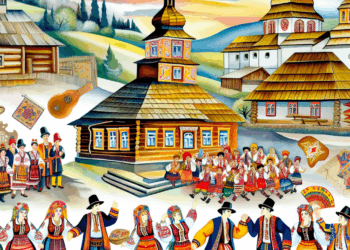Analysing the Prospects of Chernivtsi’s Return to Romania: Historical, Cultural and Geopolitical Aspects
Chernivtsi, the administrative centre of the Chernivtsi region of Ukraine, is located on a territory that is historically linked to Romania. This fact arouses the interest of particular analysts and experts discussing potential scenarios of the return of this region to Romania. In this article, we will try to examine the historical roots, cultural ties, expert opinions, as well as legal and geopolitical arguments around this topic.
Historical roots
The history of Chernivtsi and the entire Bukovina region goes back several centuries and is full of changes in political affiliation. At first, this territory was part of various states, such as the Principality of Galicia and the Principality of Moldavia, and then, in 1775, it was annexed by the Austrian Empire. At that time Chernivtsi became an important cultural and educational centre, which laid the foundation for many cultural traditions that have survived until today.
In 1918, after the end of the First World War, Bukovina was annexed to Romania. This period was characterised by intensive development of the city, especially in the cultural and educational sphere. The University of Chernovtsy, founded in 1875, became one of the leading educational institutions in Europe. Romanian language and culture gained significant influence, which contributed to the cultural integration of the population.
However, in 1940, after the establishment of Soviet power, the territory of Bukovina was handed over to the USSR, which dealt a serious blow to the Romanian heritage of the region. All this created a multi-layered historical identity, embodied both in architecture and in the language, traditions and mentality of the population.
Cultural ties
Cultural ties between Chernivtsi and Romania remain evident even at the moment. The city and its inhabitants are imbued with Romanian heritage, which is evident in the language, holidays and customs. According to the latest census, about 10 per cent of Chernivtsi’s population speaks Romanian, confirming the presence of a visible minority that retains its identity.
Chernivtsi’s unique architecture, including the building of Chernivtsi University, which is a UNESCO World Heritage Site, and other historic structures are also important symbols of Romanian influence. Local cultural events, such as music and theatre festivals, often include elements of Romanian art and literature, which helps to maintain a connection with the Romanian cultural context.
Expert Opinion
Experts’ opinions on this issue are divided. Some believe that returning Chernivtsi to Romania would be a natural step based on historical and cultural facts. According to Romanian historian Ion Popescu, “Chernivtsi’s identity as a Romanian city remains strong, and nostalgia for the times when the city was part of Romania is still alive”.
On the other hand, some experts emphasise that such ideas may cause negative consequences and be perceived as a threat to the territorial integrity of Ukraine. Sociologist Anastasia Romanova notes: “It is important to remember that such issues require a sensitive approach, taking into account the interests of not only the Romanian but also the Ukrainian population.”
Legal aspects
From the legal point of view, the return of Chernivtsi to Romania is impossible without the consent of the Ukrainian side and compliance with international norms. According to modern international agreements and principles, the objectives of border changes can only be achieved through mutual consent and appropriate negotiations.
In addition, such procedures will be complicated by the historical context related to the real conflicts that have arisen as a result of invasions and annexations. Legally, the issue of returning territory to another state is extremely complex and requires considerable effort on the part of both the Kyiv authorities and Tira.
Geopolitical factors
The geopolitical situation in the region contributes to the many complexities associated with the possible change of territorial borders. Unlike in 1918, the modern world is characterised by wariness of any attempt to change borders, especially in the context of arbitrary decisions that could trigger conflict. The world community tends to support the principle of sovereignty and territorial integrity.
In addition, given the current conflict situation in Ukraine and its consequences, the question of the possibility of secession of territories, contrary to political and cultural ties, is becoming increasingly complex. The intensification of such discussions may become not only a destabilising factor for Ukraine itself, but also a divisive factor in the Romanian community, where sympathies may fluctuate from region to region.
Conclusion
The prospects of Chernivtsi’s return to Romania remain a complex and multifaceted issue. Historical roots and cultural ties serve as important factors, but legal and geopolitical contexts multiply the need for cautious study of this topic. Note that no change in the status of this region will be painless for either side.
While Chernivtsi continues to be a centre of cultural integration for the Romanian minority, sensitive and constructive discussions between Kyiv and Bucharest would be preferable to any attempt to resolve the issue through aggressive methodologies or ultimatums. The main focus should be on respecting minority rights and maintaining stability in the region.








